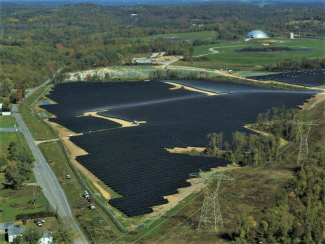NETL leadership joined local, state, and federal officials in helping FirstEnergy subsidiary Mon Power celebrate the completion of the company’s first utility-scale solar panel array — a carbon-free electricity (CFE) project made possible in part by NETL’s early first-of-its-kind commitment to purchase 100% of the power required to fulfill the electricity needs of its Morgantown, West Virginia Research Facility.
The official kickoff ceremony for the 94-acre solar-power facility that features nearly 50,000 American-made solar panels installed using local building and trade labor, was held Thursday, Jan. 4.
Acting NETL Director Sean Plasynski, Ph.D., who represented the Laboratory at the kickoff event, explained that NETL and the U.S. Department of Energy’s Office of Fossil Energy and Carbon Management (FECM) developed a unique power purchase agreement (PPA) to buy approximately 29,000 MWh of power annually from the new facility by 2025.
The PPA will enable NETL to meet a key goal established by a federal executive order well ahead of schedule. The Catalyzing Clean Energy Industries and Jobs through Federal Sustainability order has a specific goal of incorporating 100% CFE by 2030.
“Financially and technically, the goal of 100% CFE is challenging,” Plasynski said. “Initial funding requirements, the space to accommodate such a development, and access to operational expertise for large-scale power production were just a few of the obstacles that were overcome. Without the cooperation between the federal government and the private sector, achieving this goal would not have been possible. With this project, NETL and
FirstEnergy/Mon Power are showing that tackling these and other challenges is certainly achievable.”
The ground-breaking agreement that led to the solar development was so unique that NETL was contacted by other government agencies that looked to the Laboratory’s success to help guide their own progress.
“NETL and Mon Power have openly shared details of this agreement to empower other utilities, energy service companies, and federal agencies as they pursue CFE goals,” he added. “This project shows that FECM and NETL are busy on the front lines supporting adoption of sustainable and integrated energy resources within the nation’s energy supply.”
In a related initiative, NETL is installing a 1-MW solar array at NETL’s Albany, Oregon, facility, which will be interconnected with the Bonneville Power Administration’s system. That solar array is scheduled to be operational by 2026.
According to Mon Power, the solar panels, racking systems, and supporting electrical equipment at the Fort Martin site were all sourced in the U.S. As part of the company’s environmental justice initiative, plant pollinator gardens were also established across the site where space allowed. A pollinator garden contains plants to provide food and shelter to bees, birds, butterflies, moths, wasps, bats, and small mammals that pollinate plants that support the local ecosystem.
The Fort Martin facility is the first of five sites under development in West Virginia by Mon Power and its sister company Potomac Edison that will generate CFE using solar farms located on land previously disturbed or within the confines of coal operations. In August 2023, the West Virginia Public Service Commission (PSC) approved the companies’ request to construct the Fort Martin solar site and two others in Rivesville, Marion County (5.5 MW), and Marlowe, Berkeley County (5.7 MW). The companies plan to seek final approval from the PSC later this year to build the final two solar sites in Davis, Tucker County (11.5 MW), and Weirton, Hancock County (8.4 MW) once customers subscribe to the energy they will produce. Ultimately, the companies’ five sites are expected to collectively generate up to 50 megawatts of renewable energy.
According to the Solar Energy Industries Association, 1 MW of solar energy powers a national average of 173 homes. The capacity of the Fort Martin Solar Facility is 19 MW.
NETL is a DOE national laboratory that drives innovation and delivers technological solutions for an environmentally sustainable and prosperous energy future. By using its world-class talent and research facilities, NETL is ensuring affordable, abundant, and reliable energy that drives a robust economy and national security, while developing technologies to manage carbon across the full life cycle, enabling environmental sustainability for all Americans.




